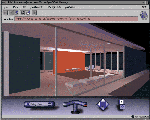This report is also available as an Acrobat file.

 Contents
Contents
1 Introduction
1.1 Adding the Third Dimension to the WWW
The World-Wide Web, which will be abbreviated to WWW or the Web throughout this document is an increasingly popular means of providing and accessing information. Its success is due to a variety of reasons, including:
- Cross-platform portability. WWW servers and clients (programs which retrieve the information held on the server) can work on different computer systems.
- It uses the infrastructure of the Internet The Web uses the global connection of networks and communication protocols of the internet.
- It is free. Generally when information is published on the Web, no charge is made for viewing it. Much of the software needed for creating, serving and browsing Web documents is also freely available.
- It is easy to use. The WWW is a multimedia hypertext system. Documents can contain links to other Web information, which are retrieved when the user selects highlighted text or images (usually by clicking with the mouse). The other information may be image, audio and video files as well as more text documents. The rich format of hyperlinked text and graphics is created using the Hypertext Markup Language (HTML).
One of the more recent developments of the World-Wide Web, is the establishment of the Virtual Reality Modelling Language (VRML) as the standard method for describing interactive three-dimensional virtual scenes on the Web. Like HTML, these 3D worlds can be hyperlinked to other resources on the Web. In fact, VRML can be thought of as a 3D equivalent of HTML, providing a three-dimensional interface to the WWW. This report will be looking in more detail at VRML and how it can be used. Incidently, VRML can be pronounced as 'vermal'.

Figure 1-1 A VRML model of the Barcelona Pavilion (67K)
The ability to create and explore three-dimensional environments on the World-Wide Web presents many interesting opportunities for art and design higher education, especially in the disciplines of architecture, interior design, landscape and 3D design. These subjects are concerned with the communication of ideas about structures and spaces. Computer modelling is now used widely in these areas, as a tool for understanding the spatial relationships within a 3D design. The importance of VRML is that it enables the models to be viewed by more people (potentially anyone with access to the WWW), on a variety of different computer systems. Hence VRML could be used as the medium for the public exhibition of work. The additional VRML multimedia feature of allowing objects to be hyperlinked to text, sounds, images, etc, may also make it a useful tool in teaching or research.
This report has been written primarily with the requirements of potential VRML users in art and design higher education in mind. However, it should be of interest to people outside this sector as well. It is assumed that the reader is acquainted with some of the terminology and basic concepts of the WWW and 3D computer graphics.
The aims of the report are as follows:
- To introduce the reader to VRML, describing its brief history, and outlining current and possible future development.
- Explain the main features of the VRML 1.0 language specification, through the use of an example.
- Describe some of the VRML browser software which are currently available for viewing VRML scenes.
- Provide some examples of the use of VRML on the WWW, with particular reference to art and design.
- Describe some of tools available for creating VRML models.
- Discuss issues concerned with making VRML files available on a Web server.
- Provide pointers to where more information about all the above can be found.
This report has been produced as part of the Support Initiative for Multimedia Applications project, funded under the JISC New Technologies Initiative and administered by the Advisory Group on Computer Graphics (AGOCG).

 Contents
Contents
Graphics Multimedia
Virtual Environments Visualisation
Contents



 Contents
Contents


 Contents
Contents